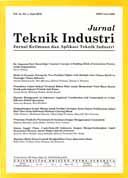Does the Ease of Starting a New Business Affect Country’s Financial Vulnerability? Evidence from Eight European Economies
 :
:
https://doi.org/10.9744/jti.22.2.123-132
Keywords:
ease of doing business, liberalization, financial vulnerability, mixed-effects estimation method, econometrics, financial engineeringAbstract
This paper investigates whether indicators on the ease of doing business explain variation of financial system vulnerability amongst eight biggest European economics between 1999 and 2014. Using mixed-effects estimation method for sectoral observations nested within countries, the results suggest that easy access to get credit is associated with increased financial vulnerability, as measured by decreased excess return in equity market. The significance of political stability, regulatory quality, and rule of law also marks the role of institutional environment towards vulnerability by facilitating the openness towards new business. Finally, a high degree of openness is not always good especially if they are combined with better institutional environment. This confirms the importance of the level of openness, as well as its channels, in determining the extent of vulnerability.
References
Aghion, P., Bacchetta, P. and Banerjee, A. (2004). Financial development and the instability of open economies. Journal of Monetary Economics, 51(6), pp.1077-1106.
Aizenmann, J. (2004). “Financial Opening: Evidence and Policy Options.” In Challenges to Globalization: Analyzing the Economics, edited by Robert E. Baldwin and L. Alan Winters. Chicago: University of Chicago Press, 2004.
Alfaro, L., and Charlton, A. (2006). International Financial Integration and Entrepreneurship. Discussion Paper 755. Centre for Economic Performance.
Arestis, P. (2005). Financial Liberalisation and the Relationship between Finance and Growth. Working Paper 05/05. University of Cambridge Centre for Economic and Public Policy.
Aspachs, O., Goodhart, C., Tsomocos, D. and Zicchino, L. (2006). Towards a Measure of Financial Fragility. Annals of Finance, 3(1), pp.37-74.
Bekaert, G., Ehrmann, M., Fratzscher, M. and Mehl, A. (2014). The Global Crisis and Equity Market Contagion. Journal of Finance, 69(6), pp.2597-2649.
Bekaert, G., Harvey, C. and Lundblad, C. (2002). Does Financial Liberalization Spur Growth? NBER Working Paper Series 8245. National Bureau of Economic Research.
Bernanke, B. and Gertler, M. (1987). Financial Fragility and Economic Performance. NBER Working Paper Series 2318. National Bureau of Economic Research.
Bryan, M.L. and Jenkins, S.P. (2013). Regression Analysis of Country Effects using Multilevel Data: A Cautionary Tale. Institute for Social and Economic Research.
Claessens, S. and Perotti, E. (2007). Finance and Inequality: Channels and Evidence. Journal of Comparative Economics, 35(4), pp.748-773.
Corbett, J. and Vines, D. (1999). Asian Currency and Financial Crises: Lessons from Vulnerability, Crisis and Collapse. The World Economy, 22(2), pp.155-177.
Dell'Ariccia, G. and Marquez, R. (2004). Information and Bank Credit Allocation. Journal of Financial Economics, 72(1), pp.185-214.
DiPrete, T. and Forristal, J. (1994). Multilevel Models: Methods and Substance. Annual Review of Sociology, 20(1), pp.331-357.
Doing Business. (2015). Distance to Frontier and Ease of Doing Business Ranking. The World Bank Group.
Fisher, I. (1933). The Debt-Deflation Theory of Great Depressions. Econometrica, 1(4), p.337.
Gardo, S. and Martin, R. (2010). The Impact of the Global Economic and Financial Crisis on Central, Eastern, and South-Eastern Europe: A Stock-Taking Exercise. Occasional Paper Series 114. European Central Bank.
Garson, G. D. (2013). “Fundamentals of Hierarchical Linear and Multilevel Modeling”. In Hierarchical Linear Modeling: Guide and Applications, edited by G. D. Garson. Los Angeles: Sage, 2013.
Goodhart, C., Sunirand, P. and Tsomocos, D. (2006). A Model to Analyse Financial Fragility. Economic Theory, 27(1), pp.107-142.
Henry, P. (2000). Stock Market Liberalization, Economic Reform, and Emerging Market Equity Prices. Journal of Finance, 55(2), pp.529-564.
Henry, P. (2000). Do Stock Market Liberalizations Cause Investment Booms? Journal of Financial Economics, 58(1-2), pp.301-334.
Illing, G. (2001). Financial Fragility, Bubbles, and Monetary Policy. CESifo Working Paper 449. Center for Economic Studies & Ifo Institute for Economic Research.
Keynes, J. (1937). The General Theory of Employment. The Quarterly Journal of Economics, 51(2), p.209.
King, R. and Levine, R. (1993). Finance, entrepreneurship and growth. Journal of Monetary Economics, 32(3), pp.513-542.
La Porta, R., Lopez-de-Silanes, F., Shleifer, A. and Vishny, R. (1998). Law and Finance. Journal of Political Economy, 106(6), p.1113.
Lagunoff, R. and Schreft, S. (2001). A Model of Financial Fragility. Journal of Economic Theory, 99(1-2), pp.220-264.
Loayza, N. and Rancière, R. (2006). Financial Development, Financial Fragility, and Growth. Journal of Money, Credit, and Banking, 38(4), pp.1051-1076.
Torres-Reyna, O. (n.d.). Multilevel Analysis ver 1.0. [Online]. [Accessed 30 July 2015]. Available from: http://www.princeton.edu/~otorres/Multilevel101.pdf
Tsomocos, D. (2003). Equilibrium Analysis, Banking and Financial Instability. Journal of Mathematical Economics, 39(5-6), pp.619-655.
Downloads
Published
How to Cite
Issue
Section
License
Articles published in the Jurnal Teknik Industri: Jurnal Keilmuan dan Aplikasi Teknik Industri will be Open-Access articles distributed under the terms and conditions of the Creative Commons Attribution License (CC BY).
![]()
This work is licensed under a Creative Commons Attribution License (CC BY).



















